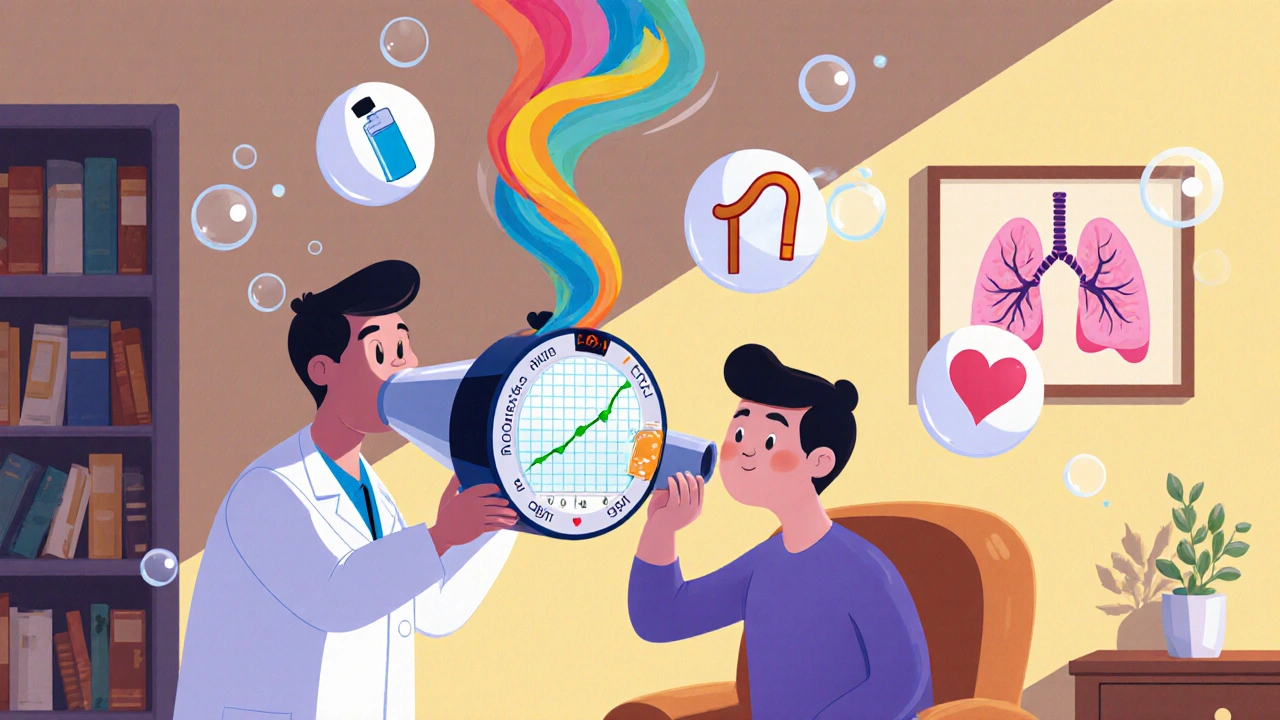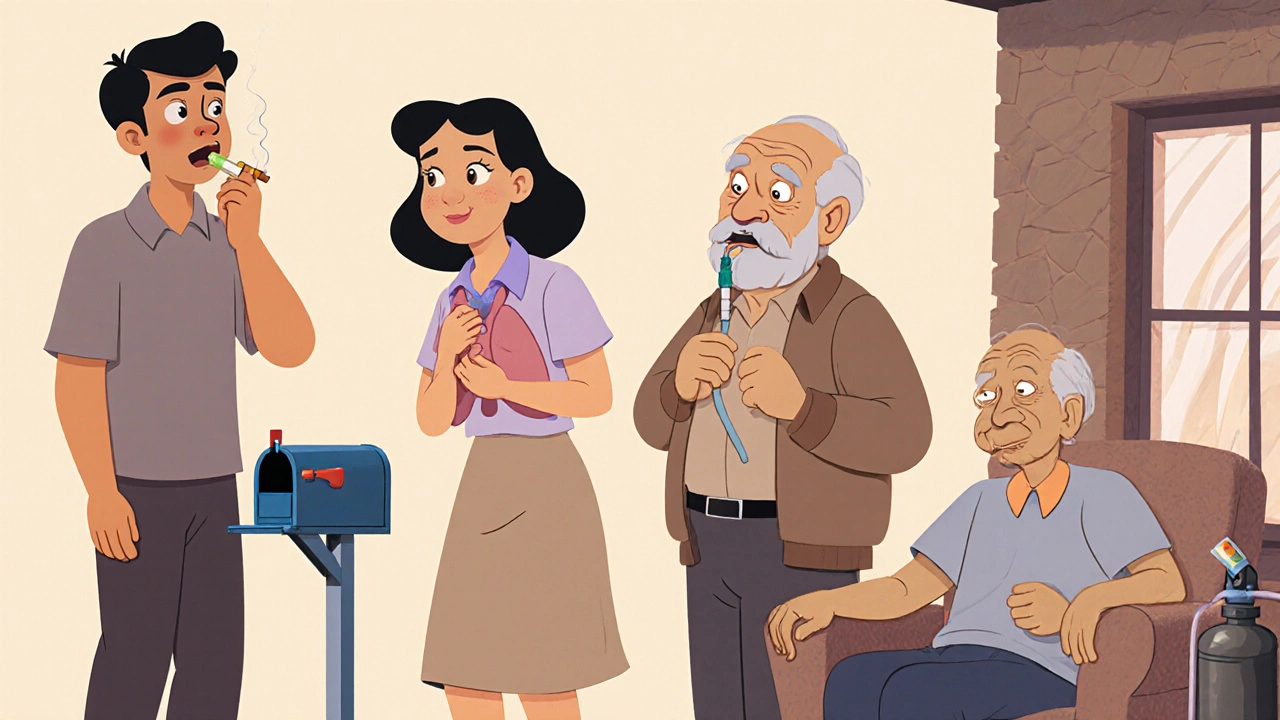Chronic Obstructive Pulmonary Disease, or COPD, isn’t just a bad cough or wheezing when you climb stairs. It’s a serious, progressive lung condition that slowly steals your ability to breathe normally. By 2023, it affected 380 million people worldwide and was the third leading cause of death globally. Most cases come from smoking-85 to 90% of them-but long-term exposure to pollution, chemical fumes, or dust can also trigger it. Unlike asthma, where airways bounce back, COPD causes permanent damage. There’s no cure. But there is hope-if you know the stages and what actually works.
What Are the Four Stages of COPD?
COPD doesn’t hit all at once. It creeps in, often unnoticed. Doctors use spirometry to measure how much air you can forcefully blow out in one second (FEV1). That number, compared to what’s normal for your age and height, tells you where you stand.Stage 1: Mild COPD means your FEV1 is 80% or higher of normal. You might have a daily cough with mucus, especially in the morning. You feel winded only after heavy lifting or running. Many people brush it off as "getting older" or "not being fit." In fact, nearly 70% of Stage 1 patients delay seeing a doctor for over two years. By then, they’ve already lost 20-30% of lung function. The good news? Quitting smoking at this stage cuts further decline by half.
Stage 2: Moderate COPD shows FEV1 between 50% and 79%. Now, breathing becomes hard during normal activities-walking to the mailbox, doing dishes, or talking without pausing. You start needing rescue inhalers more often. This is where most people finally get diagnosed. Pulmonary rehab begins here. Studies show it improves walking distance by 54 meters on average. If you’re still smoking, this is the last chance to stop before the damage accelerates.
Stage 3: Severe COPD means FEV1 drops to 30-49%. Daily tasks like showering, dressing, or cooking leave you gasping. Exacerbations-sudden worsening episodes-happen at least twice a year on average. Many need oxygen during these flares. At this point, doctors often add long-acting inhalers (LAMA/LABA combos) and sometimes inhaled steroids if you’ve had multiple flare-ups. Hospital visits become common. One patient on a COPD forum wrote: "I had to quit my warehouse job because I couldn’t walk 200 feet without stopping."
Stage 4: Very Severe (End-Stage) COPD is when FEV1 falls below 30%, or below 50% with chronic low oxygen. You’re short of breath even when sitting still. Your lips or fingertips may turn blue. Sleep becomes a struggle. Many need oxygen 15+ hours a day. Survival improves by 44% with continuous oxygen therapy, according to the landmark NOTT study. Some patients qualify for lung volume reduction surgery or even transplant-but only if under 65 and with no other major health issues. One Stage 4 patient shared: "I can’t brush my teeth without needing oxygen. Every move costs me air."
How Treatment Changes With Each Stage
Treatment isn’t one-size-fits-all. It’s built around your stage, symptoms, and how often you flare up.Stage 1: Prevention First The only proven way to slow this disease is to quit smoking. No medication can do that. Short-acting inhalers like albuterol are kept on hand for sudden breathlessness. No daily meds needed yet. Vaccines-flu and pneumonia-are essential. One study found patients who got both reduced hospitalizations by 37%.
Stage 2: Daily Control Begins Long-acting bronchodilators become standard. Tiotropium (Spiriva) or salmeterol (Serevent) are taken once or twice daily to keep airways open. Pulmonary rehab is strongly recommended-it’s not just exercise. It’s breathing techniques, nutrition advice, and mental health support. Most programs last 8-12 weeks, twice a week. And yes, insurance often covers it. Flu shots and pneumococcal vaccines are non-negotiable. About 50% of people stop taking their inhalers after six months. That’s dangerous. Missing doses leads to more flare-ups.
Stage 3: Combining Therapies Doctors add combination inhalers-LAMA + LABA-to better control symptoms. If you’ve had two or more flare-ups in a year, inhaled corticosteroids may be added. Oxygen therapy starts if your blood oxygen drops below 88% at rest. Portable oxygen units are bulky and last only 4-6 hours on a single charge. Many patients avoid leaving home because of the fear of running out. Medicare covers 80% of the cost after a $233 deductible, but the paperwork is a nightmare.
Stage 4: Life-Sustaining Care Continuous oxygen is the backbone. Some patients need 24/7 oxygen. Triple therapy (LAMA + LABA + ICS) is now standard for those with frequent exacerbations. Breztri Aerosphere, approved in September 2023, combines all three in one inhaler. For select patients, lung volume reduction surgery can improve survival by 15% over two years. Lung transplant is possible for those under 65 with FEV1 under 20% and no other life-threatening conditions. But the waitlist is long, and not everyone qualifies.

What’s New in COPD Treatment (2023-2025)
The field is moving fast. New drugs, smarter tech, and better guidelines are changing outcomes.In 2023, the GOLD guidelines updated how they group patients-not just by FEV1, but by symptoms and flare-up history. You might be Stage 2 but in Group D if you’re constantly out of breath and have had three flare-ups. That changes your treatment path.
Enisifentrine, a new drug in Phase 3 trials, showed a 13% improvement in FEV1 after 12 weeks. It’s a first-in-class inhaler that works differently than bronchodilators. If approved, it could help patients who don’t respond to current meds.
AI is stepping in too. The Kyna COPD app, cleared by the FDA in June 2023, tracks your symptoms, activity, and sleep. It predicts a flare-up with 82% accuracy-giving you time to call your doctor before you end up in the ER.
And genetics? The NIH’s COPDGene study found 82 gene variants linked to how fast COPD worsens. In the next five years, we may see treatments tailored to your specific genetic profile.
The Real Challenges Patients Face
Knowing what to do isn’t the same as doing it.Most people use their inhalers wrong. Studies show 70-80% make mistakes-like not holding their breath after inhaling, or not shaking the device. That means they’re getting maybe 10% of the medicine. You need a nurse or pharmacist to watch you use it-three to five times-until you get it right.
Cost is a huge barrier. Spiriva costs $350-$400 a month without insurance. Many choose to skip doses or split pills. Oxygen equipment is expensive and hard to move. One study found 62% of users feel trapped at home because their portable unit won’t last through a grocery trip.
And mental health? Depression and anxiety affect more than half of Stage 3 and 4 patients. The constant fear of running out of breath makes people withdraw. Support groups help. The COPD Foundation runs 85 local chapters and has 25,000 active online members. Talking to others who get it makes a difference.

What You Can Do Right Now
If you have COPD-or think you might:- Get a spirometry test. Don’t wait for symptoms to get worse.
- Quit smoking. No medication works as well as this.
- Get vaccinated. Flu, pneumonia, and COVID-19 shots are lifesavers.
- Ask about pulmonary rehab. It’s covered by Medicare and most insurers.
- Learn how to use your inhaler. Ask your pharmacist to watch you.
- Track your symptoms. Use a notebook or app. Note when you feel worse.
- Know your exacerbation signs: more cough, thicker mucus, more wheezing, swollen ankles. Call your doctor early.
If you’re in Stage 1 or 2, you still have control. The disease slows down when you act. In Stage 3 or 4, you’re not out of options-you just need the right plan. COPD isn’t a death sentence. It’s a call to adapt, manage, and fight for every breath.
Can COPD be cured?
No, COPD cannot be cured. The lung damage is permanent. But it can be managed effectively. Quitting smoking, using prescribed medications, doing pulmonary rehab, and avoiding triggers can slow progression, reduce flare-ups, and improve quality of life. Many people live for years-even decades-with proper care.
How is COPD diagnosed?
COPD is diagnosed with a simple breathing test called spirometry. You blow into a tube as hard and fast as you can. The machine measures how much air you can exhale in one second (FEV1) and how much you can exhale in total (FVC). If your FEV1/FVC ratio is below 0.7 after using a bronchodilator, COPD is confirmed. Chest X-rays or CT scans may be used to rule out other conditions, but they don’t diagnose COPD.
What’s the difference between COPD and asthma?
Asthma causes reversible airway narrowing-symptoms come and go, often triggered by allergens or exercise. COPD causes permanent damage, usually from smoking, and symptoms get worse over time. Asthma often starts in childhood; COPD typically appears after age 40. Some people have both-called asthma-COPD overlap syndrome (ACOS)-which requires a different treatment approach.
Can I still exercise with COPD?
Yes-and you should. Exercise strengthens your breathing muscles and improves endurance. Many people with COPD avoid activity because they’re scared of breathlessness. But pulmonary rehab teaches you how to move safely. Walking, cycling, and light strength training are all recommended. Start slow. Use your inhaler before you begin. Oxygen users can exercise with portable units. The goal isn’t to run a marathon-it’s to stay independent.
How does oxygen therapy help?
Oxygen therapy doesn’t cure COPD, but it helps your body function better when your lungs can’t deliver enough oxygen. For patients with low blood oxygen (below 88%), using oxygen 15+ hours a day improves survival by 44%. It reduces strain on the heart, improves sleep, and can make you feel less tired. You don’t need it all the time-just during rest, sleep, or activity, depending on your needs.
What are the warning signs of a COPD flare-up?
Watch for these signs: increased shortness of breath, more frequent coughing, changes in mucus color (yellow, green, or bloody), more wheezing, swollen ankles, confusion, or feeling unusually tired. If you notice two or more of these, contact your doctor right away. Early treatment with antibiotics, steroids, or increased oxygen can prevent a hospital stay.
Is COPD hereditary?
Most cases are caused by smoking or environmental exposure. But about 1-2% of patients have a genetic condition called alpha-1 antitrypsin deficiency (AATD), which makes the lungs more vulnerable to damage-even in non-smokers. If you were diagnosed with COPD before age 45, never smoked, or have family members with lung disease, ask your doctor about testing for AATD. It’s a simple blood test.
Can I travel with COPD and oxygen?
Yes, but it takes planning. Airlines require a doctor’s letter stating you need oxygen and your flow rate. Portable oxygen concentrators (POCs) are allowed on planes, but you must bring extra batteries-enough for 150% of your flight time. Don’t rely on airline oxygen; most don’t provide it. Book ahead, call the airline, and confirm your POC is approved. Travel is possible, but preparation is key.
What Comes Next?
COPD is a lifelong condition, but it doesn’t have to define your life. The key is early detection and consistent management. If you’re in the early stages, you still have power to change your path. If you’re further along, focus on what you can control: your medications, your oxygen, your rehab, your support system.Research is moving faster than ever. New drugs, smarter apps, and personalized treatments are on the horizon. But none of them matter if you don’t know your stage or skip your inhaler. Your next breath is worth fighting for. Start today.

